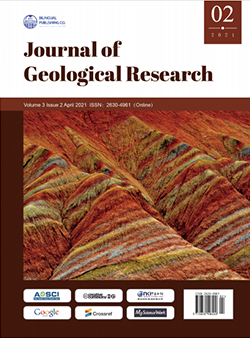Importance of Instrumentation in Hydropower Projects
DOI:
https://doi.org/10.30564/jgr.v3i2.3018Abstract
With the advancement of science and technology, humans endeavored to build massive structures, both on surface and sub –surface taking the advantage of physico-mechanical properties of the construction materials like concrete, steel, wood, rock, etc. Quality is the standard of something as measured against other things of a similar kind. The term itself is subjective until and unless quantified, cannot be controlled. Instrumentation plays a major role to quantify the quality of materials and check if the resources meet the requirements of the structural design. Several types of instruments are developed and used world-wide in different structures to monitor water pressure, seepage, movements, vibration, temperature, stress, strain and other significant parameters. The role of instrumentation specialist lies in understanding the dominating phenomena in the planned structure,designing the instrumentation network, monitoring schedules and timely analysis for cautioning the engineers,designers,quality personnel and the project management to have a check on construction measures vis-à-vis structural performance. This paper describes the role of instrumentation in hydroelectric projects with a brief case study from Bhutan Himalayas.
Keywords:
Geotechnical instrumentation; Hydropower; Quality control; Dam; Powerhouse; PHEP-IIReferences
[1] John Dunnicliff, 1998, Geotechnical instrumentation for monitoring field performance, 1-60.
[2] Concrete Dam Instrumentation Manual by US Department of the Interior, 1987.
[3] https://www.worldatlas.com/articles/the-deadliest-dam-failures-in-history.html.
[4] https://en.wikipedia.org/wiki/Dam_failure.
[5] BNV, Siva Prasad and Sripad R Naik. “Planning for Geotechnical and Geodetic Instrumentation in Underground Caverns.” Paper presented at the ISRM International Symposium - 10th Asian Rock Mechanics Symposium, Singapore, October 2018.
[6] BNV, Siva Prasad et al. Delineation of Cavity in Downstream Surge Chamber at Punatsangchhu-II Hydroelectric Project, Bhutan. Journal of Geological Research, [S.l.], v.1,n.1, May 2019. ISSN 2630-4961. DOI: https://doi.org/10.30564/jgr.v1i1.392.
[7] BNV Siva Prasad, PD Jennifer, SR Naik, R Bhusan,V Sekar and K Sudhakar, 2019, “Report on Networking and Analysis of Instrumentation Data at Dam Complex, Punatsangchhu-II Hydroelectric Project,Bhutan”, NIRM Report No. NIRM/NM1901C/01.
[8] BNV Siva Prasad, SR Naik, K Sudhakar, R Bhusan,V Sekar and A Mishra, 2017, “Report on analysis of instrumentation data and assistance in installation & monitoring of instruments at C-3 Package of Punatsangchhu-II Hydroelectric Project, Bhutan”,NIRM Report No. NIRM/NM1701C.
Downloads
How to Cite
Issue
Article Type
License
Copyright © 2021 B. N.V. Siva Prasad, Sripad R. Naik

This is an open access article under the Creative Commons Attribution-NonCommercial 4.0 International (CC BY-NC 4.0) License.
Copyright and Licensing
The authors shall retain the copyright of their work but allow the Publisher to publish, copy, distribute, and convey the work.
Journal of Geological Research publishes accepted manuscripts under Creative Commons Attribution-NonCommercial 4.0 International License (CC BY-NC 4.0). Authors who submit their papers for publication by Journal of Geological Research agree to have the CC BY-NC 4.0 license applied to their work, and that anyone is allowed to reuse the article or part of it free of charge for non-commercial use. As long as you follow the license terms and original source is properly cited, anyone may copy, redistribute the material in any medium or format, remix, transform, and build upon the material.
License Policy for Reuse of Third-Party Materials
If a manuscript submitted to the journal contains the materials which are held in copyright by a third-party, authors are responsible for obtaining permissions from the copyright holder to reuse or republish any previously published figures, illustrations, charts, tables, photographs, and text excerpts, etc. When submitting a manuscript, official written proof of permission must be provided and clearly stated in the cover letter.
The editorial office of the journal has the right to reject/retract articles that reuse third-party materials without permission.
Journal Policies on Data Sharing
We encourage authors to share articles published in our journal to other data platforms, but only if it is noted that it has been published in this journal.




 B. N.V. Siva Prasad
B. N.V. Siva Prasad

